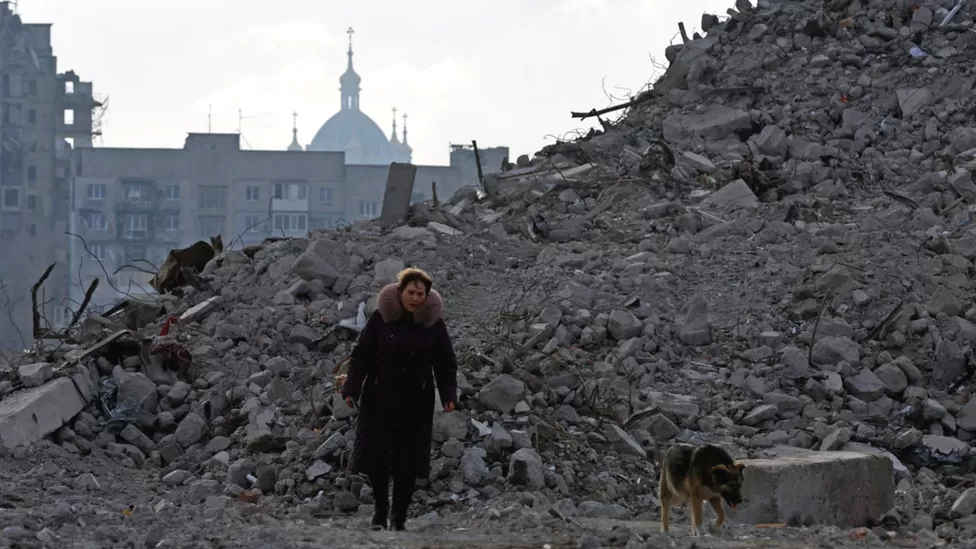Finding people willing to speak to me from Mariupol was never going to be easy.
After 10 months of Russian occupation, fear and distrust are the two most frequent responses I encountered when looking for someone who could tell me how things really are in Mariupol, in Ukraine’s south-east.
“I think you are a Russian journalist. You won’t like what I’ve got to say. People like you kill if you tell them the truth,” said one social media user who claimed to be from the port city.
Russian forces put the people of Mariupol through a horrific months-long siege, before eventually capturing it last May.
I eventually found three residents willing to speak to me at length: a local city councillor, a retired pensioner and an engineer. All spoke on condition of anonymity, fearing reprisals from the local authorities installed by Russia (who block access to occupied Ukraine by Western journalists).
They paint a picture of a massively expensive campaign conducted by Russia to win over the hearts and minds of the people of Mariupol, and rebuild a city damaged beyond recognition by Russia’s own troops.
The purpose of this campaign is to assimilate Mariupol and make it Russia’s own.
Their accounts corroborate each other, and are confirmed by social media posts about recent developments in Mariupol.
Before this war began about half a million people lived in the city.
According to UN estimates, 90% of residential buildings were damaged or destroyed, and 350,000 people were forced to leave after Russia attacked in February 2022.
It is difficult to estimate the exact number of people killed as a result of the relentless shelling of Mariupol, but Ukrainian authorities say more than 20,000 died there.
Russian-installed authorities in Mariupol say some 300,000 people are now living there.
The people who spoke to me from Mariupol said their city had been inundated with labourers from across Russia, as well as from Central Asia.
Oleg Morgun, the Russia-installed “mayor” of Mariupol, says some 70,000 of those currently in the city are construction workers and members of the Russian military.
Rebuilding
New buildings have appeared and many buildings damaged during the bombardment have gone.
For example, the Russian military has built a whole new district comprised of a dozen apartment blocks in the western part of Mariupol. It is called Nevsky, after the River Neva, on which President Vladimir Putin’s home city of St Petersburg stands. According to Russian state media, St Petersburg is the main sponsor of the reconstruction of Mariupol.
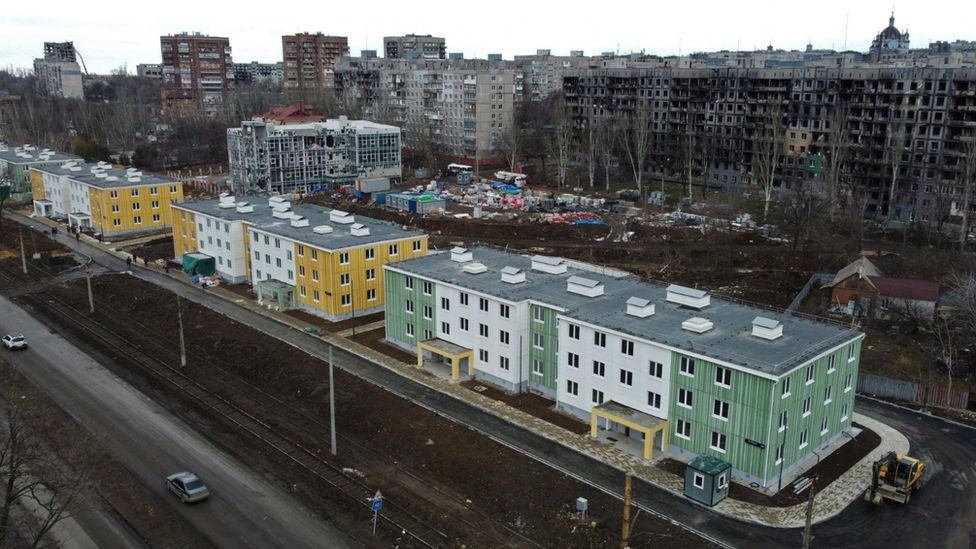
“It says on the bus: St Petersburg and Mariupol are twinned cities. There are slogans everywhere telling us that we’re part of Russia now,” pensioner Maria (not her real name) told me.
“I liked things the way they used to be. Now we live in fear. We have no idea what to expect.”
In the houses that escaped relatively unscathed after months of fierce fighting, the Russians are replacing windows, radiators and sometimes heating and sewage pipes.
Heating, running water and electricity supplies have largely been restored. Buses are running and full of passengers again, although the electric trolley bus and tram networks are still out of action.
Many schools, hospitals and shops have reopened as well, although numerous traders are selling their wares straight from the pavement.
Maria was particularly impressed with one school rebuilt under Russian rule: “It’s so beautiful, covered in multi-coloured squares.” According to her, the number of children in Mariupol now is greater than schools can currently accommodate, so they have classes in two shifts: one in the morning, and another in the afternoon.
Russian has imposed its own Russian-language curriculum in occupied areas – complicating efforts to get children back to school.
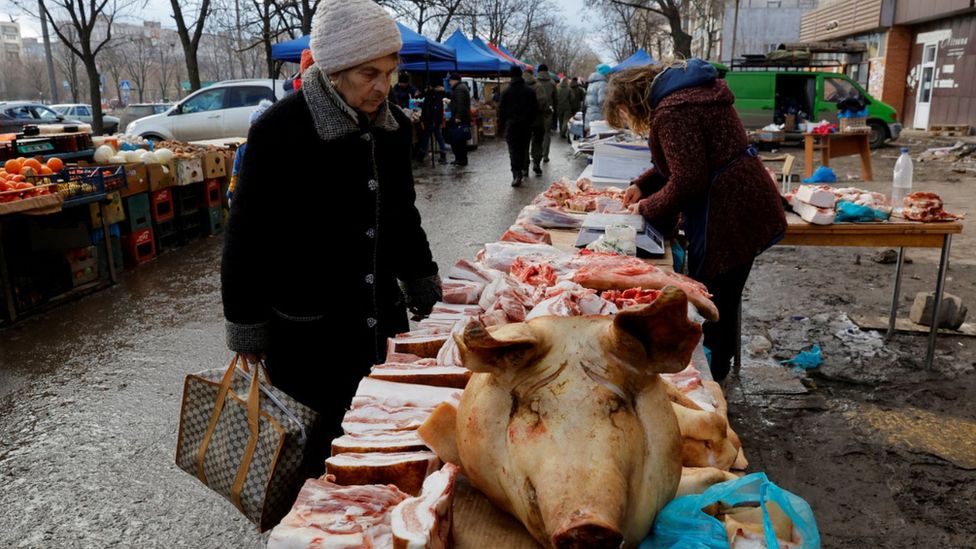
The fast-paced rebuilding of Mariupol has provoked envy in Donetsk, the regional capital occupied by pro-Russian forces since 2014, which has been neglected by comparison.
The Russia-installed head of the so-called Donetsk People’s Republic, Denis Pushilin, has even had to deny rumours that the capital will be moved to Mariupol.
Assimilation
There are other important ways in which Russia is putting its stamp on Mariupol.
For example, local residents are under pressure to obtain Russian passports.
Ivan, the Mariupol city councillor I spoke to (not his real name), said locals often formed “huge queues” trying to get Russian passports.
They were required if you want to find formal employment, especially with government agencies or in the public sector, he explained.
Also, they made it possible to travel to Russia without additional stringent checks known as “filtration”, he added.
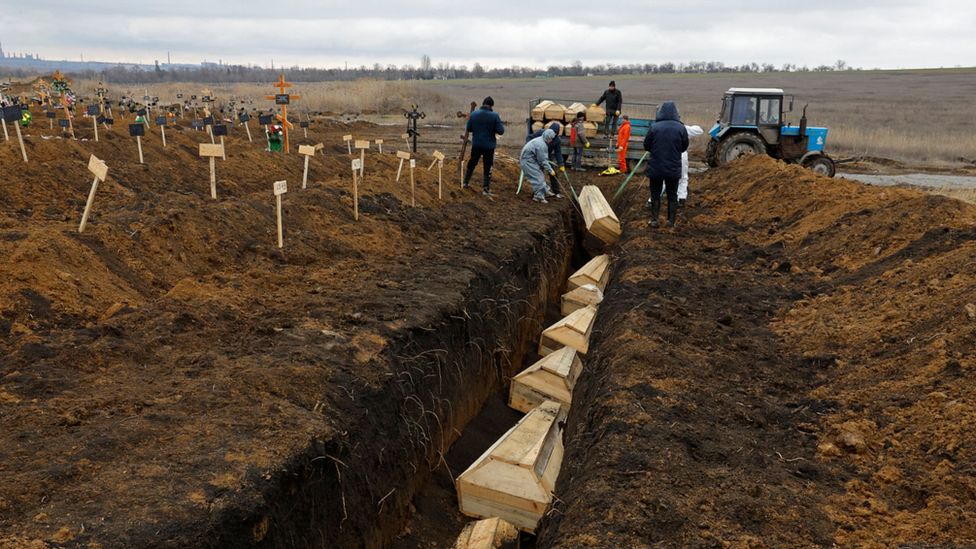
“So they have deliberately created a situation where you get problems if you have Ukrainian papers, you have to deal with red tape, you have to wait. On the other hand, if you get a Russian passport, that’s where your problems end: ‘You’re one of us now’. Things get simpler if you receive a Russian passport,” Ivan said.
Mariupol is also becoming part of Russia’s financial system. The Ukrainian currency, the hryvnya, has been phased out, and now the Russian rouble is the only currency accepted in shops.
Russia is channelling huge amounts of money into pension payments for residents of Mariupol, raising them in many cases compared with what they received from the Ukrainian authorities before the war. So residents of Mariupol are able to draw two pensions – one from Russia, another from Ukraine. Naturally, it is a situation many local pensioners are happy with.
Russian pensions are another reason why elderly residents are queuing up to get Russian passports – many pensioners believe the documents will be required in the future to continue receiving payments from Russia.
The media currently operating in Mariupol are also hard at work promoting a uniformly pro-Russian agenda.
Pro-Russian sentiment
Many current residents of Mariupol are there because they were unable to leave the city when the Russians attacked, due to illness or old age, or because they welcome Russia’s presence.
“We’ve suffered enough under Ukraine. Now we can breathe again,” one social media user told me, before breaking off all contact.
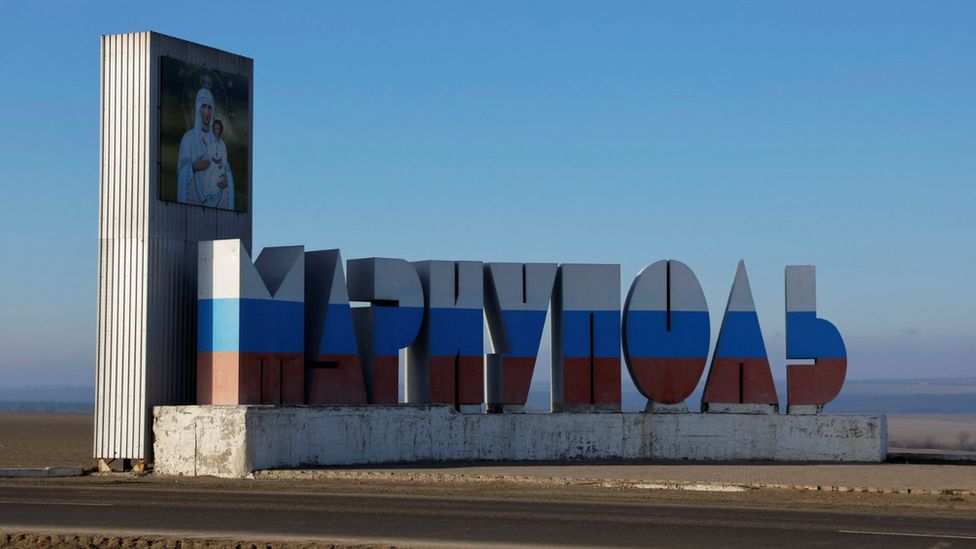
The fast-paced campaign of reconstruction and the resulting sense of restored normality, the generous pension payments and the intensive media campaign targeting the people of Mariupol, all stimulate the spread of pro-Russian sentiment in the city.
“I’m sick of all the propaganda in the papers. They started publishing it from day one, telling us how well things are going,” said Yuri, the engineer (not his real name). “I feel out of place in my own city now. People are different, my city feels different now.”
City councillor Ivan said: “It’s become difficult for me to say pro-Ukrainian things to my voters. It’s tough being pro-Ukrainian in a pro-Russian environment. Unfortunately, Ukraine is losing the hearts and minds of people in Mariupol.”
Those who are still in Mariupol may be happy to see a degree of normality return to their city, but there are those who suspect Russia of pursuing ulterior motives.
Popular Ukrainian journalist Denys Kazansky argues that Russia uses the new houses it has been building in Mariupol to distract attention from all the destruction it caused in the city and elsewhere in his native Donetsk region.
“If they destroyed 10 hospitals and then rebuilt one – this isn’t reconstruction. It’s not something they can be thanked for,” he said.
“You can be happy as much as you like about a school being rebuilt, but what do you do with the thousands of people Russia has killed?” he said.
“You can’t rebuild them. You can’t bring them back.”
Source : BBC

